Every year at the start of August, farmers are encouraged to share their day online as part of 24 Hours in Farming #Farm24. We took part again this year and shared all the goings on from Bottom Farm.
First, we headed out to find Marvin cultivating. This field was growing wheat this year which has now been harvested, we leave the wheat stubble in the field to biodegrade and nourish the soil. We are planning on planting beans in this field in October and beans need to be planted quite deep into the ground. Marvin has to cultivate the soil to loosen the top layer to make it possible for us to plant the beans. This is a big field and the cultivator needs to be driven quite slowly so this will take the majority of the day!
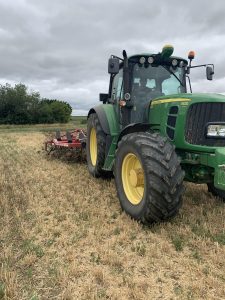
We then headed back to the farm yard, passing the combine harvester which is having a rest until the spring barley is ready to be harvested.
![]()
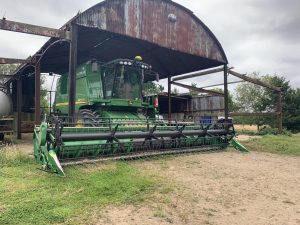
Here are the wild flowers we have growing around our spring barley. These flowers provide habitats for insects and is great for pollinators.
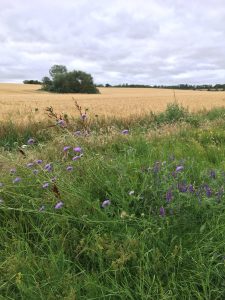
We even have these beautiful daisies in the wildflower meadow margins, and Duncan explained these are actually chamomile for making into tea!
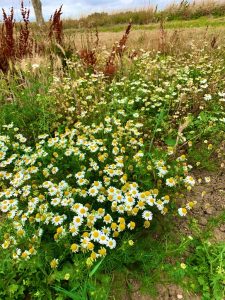
The last stop on our way back to the farmyard was these trees. Duncan planted them back in 1989 and they are just a few of the 8000 trees he has planted on the farm over the years.
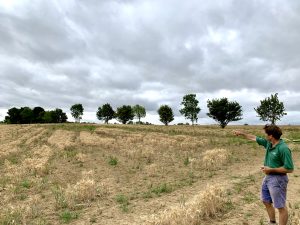
Heading into our rapeseed oil production area, we watched the team pressing and bottling our Mellow Yellow Rapeseed Oil. We cold press our rapeseed on our farm. Our presses run 24/7 to produce Mellow Yellow Rapeseed Oil for kitchens up and down the country! We call it the process of no process. Simply sow, grow, press and bottle!
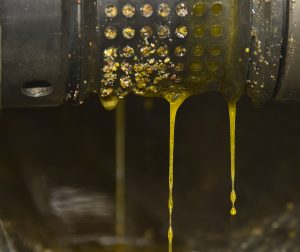
We harvested our rapeseed a few weeks ago and this what the little seeds look like. They’re bright yellow inside and packed full of delicious and nutritious oil!
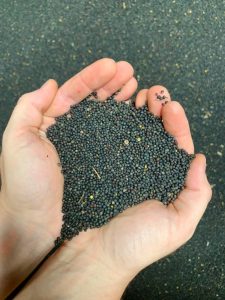
After lunch, Duncan headed out to do some mowing. Tidying up the edges of fields already combined and making sure the various public footpaths we have going through the farm are clear and accessible for people on their daily walks!
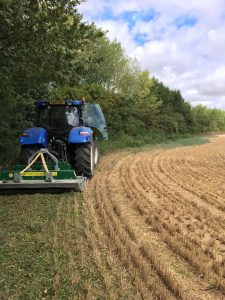
Before we harvest the wheat, we need to check the moisture content, still a few more days of sunshine needed for this field! Duncan is winnowing here – blowing air through the wheat to remove the chaff!
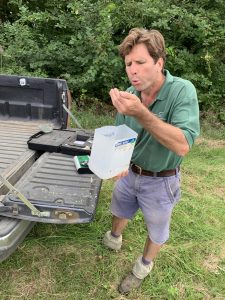
We then left Marvin finishing off the cultivating and that was our day!
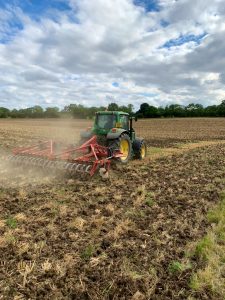
We had a great time sharing our day on the farm and we hope you enjoyed getting an insight into British farming! See you next year!
What is rapeseed oil? Let us answer that for you here…
Rapeseed oil is the oil extracted from the small black seeds found in seed pods grown on the rapeseed plant, Brassica napus, a plant species which is a member of the brassica family. These seeds are tiny, quite hard black seeds with a bright yellow centre which holds a high oil content. To release this oil, the seeds must be either pressed or processed at a high temperature.
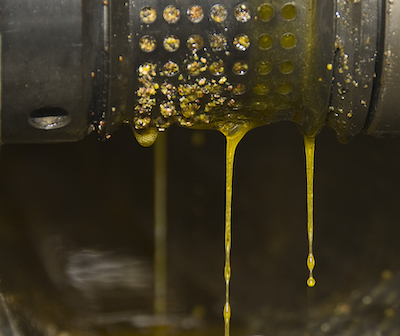
Rapeseed oil dripping from a press
We produce our Mellow Yellow Rapeseed Oil by a traditional cold pressing method which we like to call the ‘process of no process’. We simply squeeze the seeds in a screw press and collect the oil that is released. The screw press is very simple and is an incredibly traditional food production method. A slowly turning screw uses pressure to gently squeeze the seeds which releases the oil. This oil is then passed through a filter (a bit like coffee paper) and then it is ready to go into bottles to be used in your kitchen.
Not all rapeseed oil is produced in the same way though. Some companies use a chemical extraction method to produce refined rapeseed oil. This involves quite an intense process where the rapeseed oil is extracted from the seeds under high temperatures, then is bleached and deodorised using chemicals to create a flavourless and colourless oil. This is often sold as vegetable oil in large quantities to be used for deep frying.
Stages of growth of a rapeseed plant
We sow the seeds into the earth in August straight after harvest time. The seeds are then left to grow throughout September and October with the rain at this time of year helping. Growth slows down from November to February until Spring arrives and it starts to warm up. We put fertiliser on the fields at this time to help the growth. From April onwards, the rapeseed plant continues to grow, becoming a tall, green plant with yellow flowers, about 1m high.
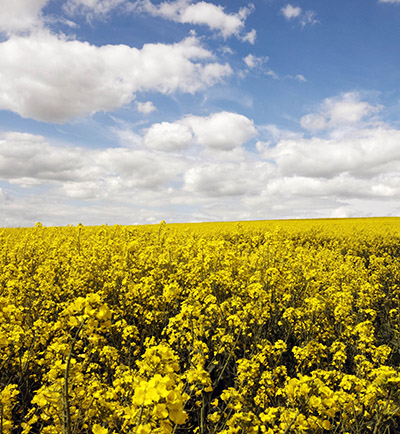
Rapeseed flowers
These yellow flowers appear around May and June time. The flowers then die, leaving a seed pod to grow in their place. This seed pod develops over the late summer months until August when harvest takes place.
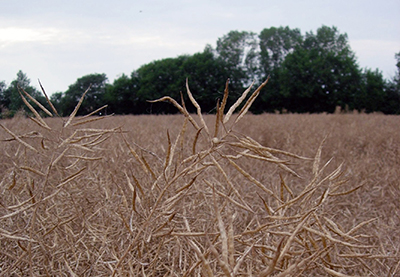
Rapeseed pods ready for harvest
A combine harvester cuts down the plant and breaks the seed pods open to release all the little black seeds that have formed. These seeds can then either be planted again to grow even more rapeseed plants the next year, or can be gently cold pressed to produce cold pressed rapeseed oil.
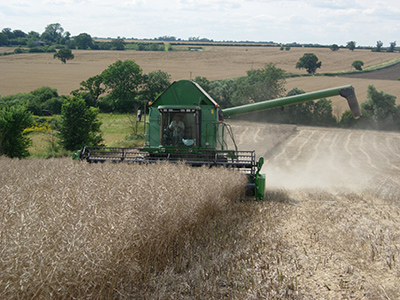
Harvesting rapeseed
What is rapeseed oil also known as?
In the UK, we refer to it as ‘rapeseed oil’ or ‘cold pressed rapeseed oil’ depending on the way it is produced. However, in Canada and the USA, they know it as ‘canola oil’. This stands for Canadian Oil Low Acid, which refers to the low erucic acid of the product.
Some people ask us if we use any genetically modified (GM) rapeseed. Our seeds are not GM and additionally, they are LEAF Marque. LEAF stands for Linking the Environment And Farming and means that they we are independently audited to ensure that our farming methods are both sustainable and sensitive to the environment.
What is rapeseed oil used for?
With a high smoke point, rapeseed oil is a brilliant culinary oil and is great for roasting, frying, baking or dressing. Take a look at our recipes using Mellow Yellow Rapeseed Oil here. As well as a culinary oil, we use our Mellow Yellow Cold Pressed Rapeseed Oil as an ingredient for our range of salad dressings, infused oil and mayonnaise. With its subtle nutty flavour and low saturated fat content, it is perfect for this and creates delicious and healthy dressings and mayonnaise with a beautiful yellow colour.

Mellow Yellow range
What is so special about Mellow Yellow Rapeseed Oil?
– Duncan Farrington, a fourth generation farmer, was the UK’s original seed-to-bottle producer of cold pressed rapeseed oil back in 2005.
– Our rapeseed is grown to LEAF Marque standards, a system designed to promote environmentally responsible and sustainable farming.
– Grown, cold pressed and bottled on the Farrington’s family farm in Northamptonshire.
– Flavour is key. Our cold pressed rapeseed oil is not brash or punchy, with mellow nutty and buttery tones.
– 90% less saturated fat than coconut oil and half the saturated fat of olive oil.
– Ten times more Omega 3 than olive oil with a healthy balance of Omega 3, 6 and 9.
So what is rapeseed oil? It is a brilliant culinary oil that is produced from the oil found in seeds from the rapeseed plant. Cold pressed rapeseed oil is produced by gently squeezing the seeds and has a subtle nutty flavour and is low in saturated fat with a high smoke point. Find out more about Farrington’s Mellow Yellow Rapeseed Oil here and find your local stockist here.
On the 8th August, we took part in 24 Hours in Farming, the agricultural industry’s biggest online event, which highlights the pride of the nation’s food producers and encourages farmers to show the general public a typical working day through the power of social media using the hashtag #Farm24. Starting at 5am on Thursday 8th and finishing at 5am on Friday 9th, this 24 hour event encouraged British farmers to share an insight into their day to show consumers the effort and care that goes into producing their food.
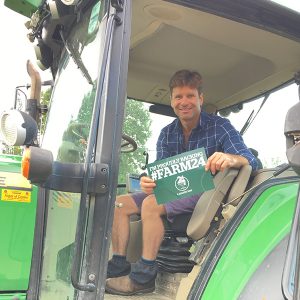
Duncan Farrington ready for #Farm24
Starting first thing in the morning, Duncan had to move all the barley in the barn back as far as possible, to give plenty of room for the barley he was due to the harvest throughout the day.
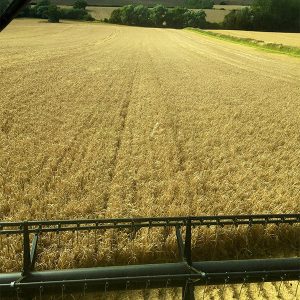
View from inside the combine harvester
Meanwhile, Robert (Duncan’s father) and Marvin (our farm worker) started preparing the combine harvester. This involved cleaning the windscreen, blowing the dust from the combine to reduce fire risk, setting up the GPS and getting the combine ready for a busy day. Once everything was set, Marvin starting combining. We use GPS to pinpoint our location in the field and steer the combine through the field, ensuring that each length of the field is harvested as efficiently as possible, reducing fuel usage and taking less time.
We were harvesting spring barley on this particular day. This year our spring barley was destined to be made into malt for beer, so a fairly important crop in our opinion!
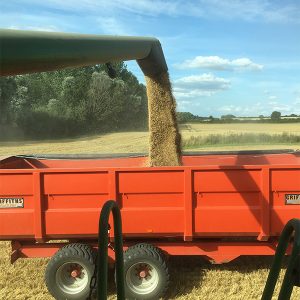
Barley being unloaded into the trailer
Whilst Marvin drove the combine, Duncan and Robert took it in turns to fill a trailer load of harvested barley from the combine and take it back to the farm yard and tip it into the barn. By having both Duncan and Robert do this, they were able to keep up with the speed Marvin was harvesting at so the combine didn’t have to stop at any point.
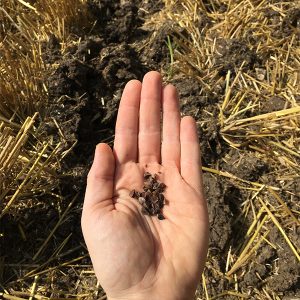
Cover crop seeds – buckwheat & phacelia
We visited another field on Bottom Farm, this one was harvested a few days previously and then planted with cover crops. We use cover crops to improve the health of our soil, but the key benefit is the fact that they absorb CO2 from the atmosphere and store the carbon in the soil (more info here). We planted buckwheat (the bigger, pyramid shaped seeds) which scavenge for phosphate and helps young plants’ root development. We also planted phacelia (the tiny seeds) which have fibrous roots for soil structure. On the same day as #Farm24, the UN also released their latest climate change report, which highlighted the importance of soil and storing carbon from the atmosphere in soil, which is exactly what our cover crops do!
Whilst Duncan was busy with harvest, his wife Eli jumped in a tractor and rolled the fields of cover crops. Rolling smooths the field and ensures the seeds are pushed into a good soil base to give them the best chance for growing.
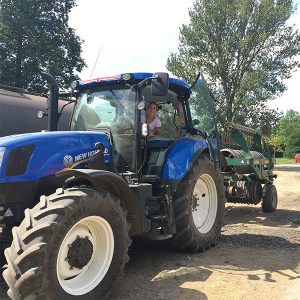
Eli Farrington in tractor
Next, we headed over to the Mellow Yellow production barn. Mellow Yellow Rapeseed Oil is grown, pressed and bottled on the farm. First of all, the seeds go into big yellow hoppers which feeds the seed into the presses. The seed is then cold pressed which involves being gently squeezed until the yellow oil is released. The seed husk is not wasted, it is shaped into pellets and sold to local farmers as high quality animal feed for cattle, pigs and sheep.
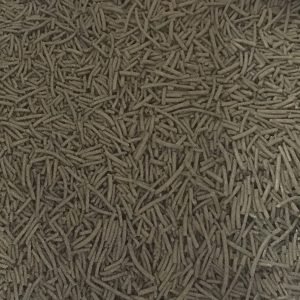
Rapemeal
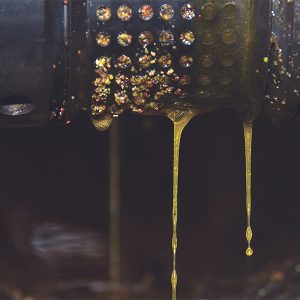
Rapeseed oil dripping from press
Once the seed has been pressed, the oil trickles out and is simply passed through a filter, a bit like coffee paper, before it is put into bottles. These bottles were then destined for Morrisons, the sponsors of 24 Hours in Farming, a lovely coincidence!
Returning back to the combine harvester, Duncan, Robert and Marvin had lots of barley to harvest, so ended up going until half 10 that night, it’s a good thing the combine has headlights! By the end of the day, we had managed to harvest all the barley, which we were VERY pleased with, especially as rain started to fall the minute after we had shut the combine into the barn, perfect timing or what! The weather often causes problems around harvest, the crops may be ready but if it’s raining, we can’t combine as the moisture levels must be low.
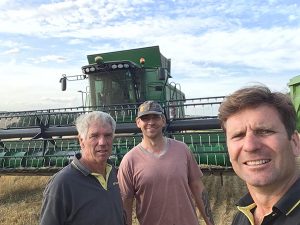
Duncan, Robert and Marvin after a busy day’s harvesting
Throughout the day, hundreds and thousands of British farmers and food producers shared images and videos from their day with #Farm24. It was a fantastic day for learning about how our food is produced. #Farm24 was trending for most of the day and over 8 million people saw the photos and videos shared throughout the day! For more information on 24 Hours in Farming, please visit Farmer’s Guardian here: https://www.fginsight.com/24hoursinfarming/sponsored—24hoursinfarming
Bottom Farm is an arable farm, in other words, we grow crops and not animals. However, when giving talks on sustainable agriculture, I sometimes say that we do have livestock on Bottom Farm in the form of worms, pollinating insects, beetles and a whole host of other beneficial little creepy crawlies that help me grow my crops. They help by recycling old plant debris to create plant food for the growing crops in the case of worms; or pollinating our rapeseed and beans in the case of pollinating insects; or indeed helping with my pest control, in the case of the beetles that eat unwanted aphids on the crops. But in the more traditional sense, we don’t usually have livestock on the farm.
As part of a good sustainable farming system, I grow a healthy rotation of different crops around the farm each year. The basis of this being that different crops take different things from the soil and put different things back. In addition to growing different crop types, we also plant crops at different times of the year which helps in breaking weed and disease cycles. Generally, we plant crops in either the autumn or the spring.
Before planting a spring crop of say, barley, I plant a cover crop in the autumn. A cover crop does just as it says, it covers the ground, protecting the soil from winter rains. By growing a crop throughout the winter months means the growing roots are holding onto precious minerals rather than being washed away in the rainfall. The roots also keep the soil in good structural condition, keeping it lovely and friable for the following spring crop. Finally, the growing crops provide a food source for all those little creepy crawly animals and bacteria in the soil that work altogether to make a healthy fertile soil.
I have tried several different crops over the years and currently favour a mixture of crop species, this includes oats, vetch, phacelia and buckwheat for example, each adding their own little bit of magic to the mix. Generally, I plant the cover crops in August or September and allow them to grow until January or February. As soon as the weather conditions allow, we will apply a herbicide to the crop to kill it off, giving it time to die and breakdown in readiness for the spring barley to be planted in March or April. By giving time for the crop to breakdown, all the bugs in the soil will start converting some of the plant material into nutrition ready for the new planted barley to feed on and grow healthily into a crop to be harvested.
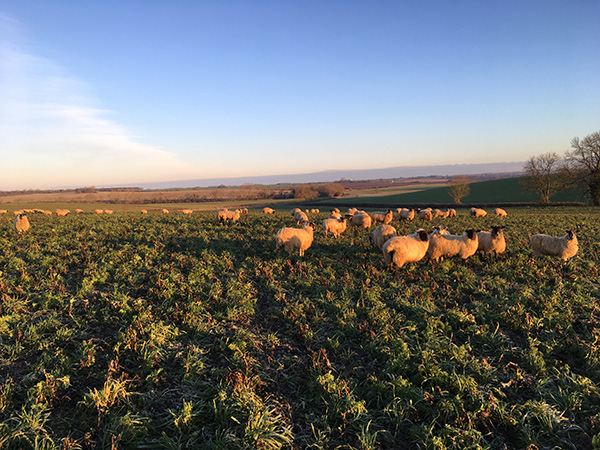
However, let’s return to the topic of livestock on Bottom Farm! Over the last few years, on some of the cover crop fields I have used sheep to graze off the vegetation in readiness to plant the following crop. This traditional method of destroying the cover crop is sometimes called the ‘golden hoof’, as the sheep not only remove the crop, but in the process, convert it into a fresh source of manure, thereby fertilising the soil. The sheep are not mine, but belong to a local farmer who takes them from farm to farm, where he gets good quality grazing for his flock, whilst providing us with an excellent lawnmower and fertiliser service. It does mean for a few weeks a year, I become a livestock farmer and we have sheep on Bottom Farm. I thoroughly enjoy walking the field every morning to check they are all still there and happily grazing. You could say it makes me feel like a real farmer, using traditional methods in our very modern world.
You can learn more about our sustainable farming practises here.

Duncan Farrington
I have been asked in the past what we do in the winter months. People comment, saying “Surely as an arable farmer, you plant the crops in the autumn, go away on holiday and come back the following summer ready to harvest them?” Nice thought, but I’m afraid the reality is a little different.
Admittedly, on an arable farm, where we only grow crops and do not have any livestock to look after, the winter months are quiet and it can be an opportunity to relax on a holiday if you wish. However, I have always found it the time of year for research, planning and projects, of which we have done many over the years. Back around the millennium, I remember spending many winter months researching the viability of creating a cold pressed rapeseed oil business on our farm, as a diversification project on something I found very interesting and to hopefully bring a little extra income to the family business. Looking back, I think this was time very well spent.
Of course winter is an ideal time for us to service all the farm machinery in preparation for the coming spring and summer months when we will want it to work long and hard without too many breakdowns. We have done many building projects over the years, both for new machinery ideas and for buildings on the farm. Some examples have been building a new trailer, or creating a water bowser. In the past, when I was a young boy and even before I was born, my Father and Grandfather were at their happiest creating new weird and wonderful machines in the farm workshop. Two of the most extravagant examples included a six-wheel drive tractor, converted from a World War II army fire engine. I remember going across the fields with them on this machine, before it finally over heated and was retired in the nettles. Their most famous project was when they took two normal tractors, replaced the standard engines with more powerful versions, before removing the front axils off both tractors and joining them together to make an articulated four-wheel drive machine, driven by one person from the back tractor. This was certainly cutting-edge engineering in its day, that was later copied and refined by machinery manufacturers in future years.
We have restored our beautiful traditional barns and converted them from redundant old farm buildings into offices, including our farm office today. New modern grain stores have been designed and built to cope with storing and drying the grain at the speed the modern combine harvester brings the crops in. Over the years, we have built all of the factory and some of the machinery inside it for Farrington Oils. Some of these projects seem to start as winter job ideas, but tend to stretch through other months of the year and before long take on a whole life of their own. The most recent being the latest expansion of Farrington Oils to create a new toilet and changing facilities, as well as extra space to mix our salad dressings and store ingredients. We have even made a little development kitchen in which Eli is currently very busy with her trusted jam jar creating some possible exciting new dressing recipes. This whole project started in April last year, we had a few weeks break for harvest to take place, before finally finishing the project just before Christmas.
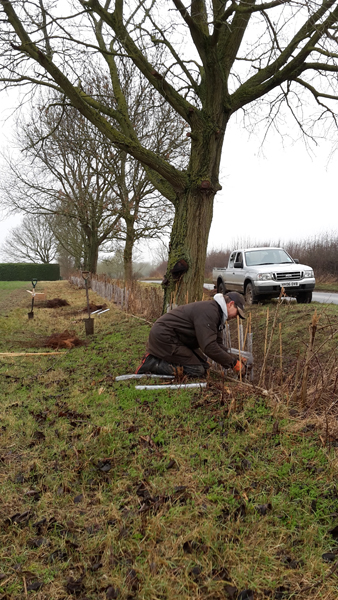
Marvin planting saplings in Jan 2018
The other main type of project we have done during winter over the years is planting trees and hedges. We have literally planted thousands of trees and several kilometres of hedges since 1987 when my Father planted the first couple of spinneys on the farm. They are now well established, adding beauty and wildlife habitats to the landscape. This year we have been at it again. Marvin spent the time before Christmas with the chainsaw, thinning out dead wood from a copse area and old hedge, in readiness to replant with new young saplings in the first weeks of January. He has now created a few hundred more metres of hedgerow – Father and I have helped him with the spade to get some of the 2,000 hedge and tree plants put into the soil. We will have to weed around the young saplings for the first two years, after that they will hopefully grow and thrive, adding more beauty and wildlife habitat for many years to come. Additionally, we have a pile of wood ready to cut up for the fire to keep us warm at home next year.
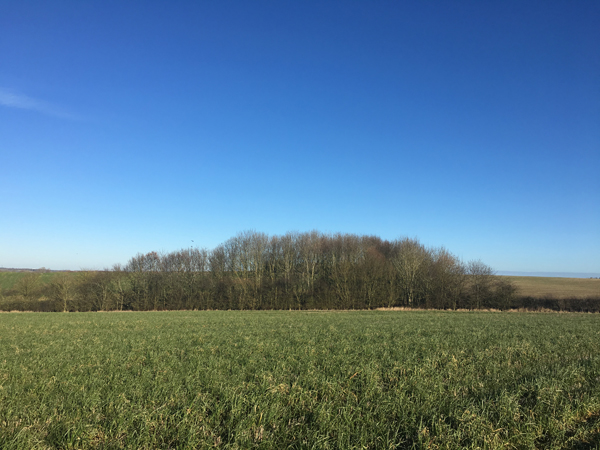
Spinney on Bottom Farm that was planted in 1987, photo taken Feb 2018.
Although winter on Bottom Farm may not be spent on a combine harvester or tractor, it certainly is far from quiet!
Harvest finished in the second week of September, it was a rather drawn out event in the end, but on the whole went well. The new combine was the highlight of the year, a great machine that will hopefully be serving us well for the next decade. However, being a farmer, there is always something to worry about and this year it is the prices. The collapse in milk prices over the last year has been well published; but now it is hitting home with me of the 30% reduction in grain prices also, with no immediate prospect of a recovery on the horizon.
To take my mind off impending gloom on the current viability of British agriculture, I was delighted that our work in Farrington Oils has come to the attention of some influential people, like His Royal Highness.
A couple of weeks ago, I had a mysterious phone call to say we had been selected for a royal visit, to the home of Farrington’s Mellow Yellow “if you are interested?” Of course, we were interested, but the catch was it all had to be arranged within a few days. The timing was perfect for us as we have been investing in the business, hence we had something to talk about and see.
We hastily invited local councillors, colleagues, and customers to the event, with everyone being asked to keep it quiet. The drivers and armed police came out to check everything were up to scratch, with no security issues. Floors were scrubbed, equipment polished, whilst my mother and Eli made some Mellow Yellow inspired cakes and made sure we had enough cups and saucers to hand.
It also allowed us to exert some pressure on the local engineers to finish off the work in time for the occasion, it being finally finished the evening beforehand. We have installed more oil presses, increasing our capacity by two-thirds, along with two impressive oil storage tanks, increasing capacity by 400%. On the morning we busily gave the new equipment a final check-over before starting it working, nervously checking for leaks and issues, before getting changed into suit and tie.
His Royal Highness the Duke of Gloucester came to visit, spending time touring our factory and meeting the team. He bottled his own oil, before enjoying refreshments, chatting to our guests. It was a great event, I was very proud to show off our team at Farrington Oils. I was delighted to talk about our investment in equipment, a new staff position to look after national sales and our two latest export customers in the Middle East and Asia.
Following the visit, everyone was really pleased with a job well done, although exhausted. It is fantastic for company moral to be able to do something different and exciting occasionally; to invite customers and other guests to show them first hand what we do and, to be proud of our village and our county.
In the following weeks of June, we have been getting ready to harvest which will now soon be upon us. Marvin has been busy cleaning the grain store from top to bottom, with the help of a German exchange student who stayed with us for five weeks to learn about life on a British farm. He has also methodically gone through every piece of machinery that will be used over the next four months. Each machine has been brought to the workshop. Worn out or broken bearings, pipes, electrical wires, and parts have been repaired and replaced, before the machine is then washed and greased in readiness for work. No doubt there will be something we have missed which will come to light as soon as the machine is used, but good preparations should reduce the chances of downtime when we don’t need it.
At the same time, we are currently making the largest investment to date in Farrington Oils, increasing our oil pressing capacity by two-thirds. I have bought four extra oil presses and storage tanks that have arrived and are waiting to be installed. Father and others are fabricating hoppers and frames for the installation. It is a full team effort in order to get everything finished before harvest, firstly because we will not have time for building projects once the combine starts rolling and secondly because we need the space, as the farm yard currently looks more like an engineering works with half-built machines scattered around the place.
The weather continues to be wonderful in Hargrave over the last few weeks. Unfortunately, although I hate to say, but a little rain would have been appreciated. One day my daughters came back from school in the nearby town, soaked to the skin from a heavy rain storm while they were playing sport, while the sun continued to shine in Hargrave. It is a common occurrence that rain misses Hargrave; there must be some very righteous people living in our village. My only hope is that we do not get a repeat of last year, where the heavens open during August, which was the wettest month of last year by some margin.
Come and meet the family, we have added two new products to the Farrington range this year! Many shops are enjoying great success with the whole range, but if you have yet to try them, then please do come and visit us on stand 1135 at the Speciality & Fine Food Fair in London on 6-8 September.
Northamptonshire’s Finest!
We were delighted to scoop Runner Up prize for Best Local Product at the Northamptonshire Food and Drink Awards 2009, held at Holdenby House last week. The judges included celebrity chef Sophie Grigson, Michelin-starred Aday Gray, chef Stephen Bulmer (all long term Mellow Yellow fans) and of course, the general public! Although a national brand, Mellow Yellow is proud of its roots and didn’t mind coming second to local butcher Sauls of Spratton’s excellent potted beef, especially as they do, of course stock Mellow Yellow!
Farming update
As you will no doubt be aware, we are Britain’s original “seed to bottle” producer. We are pleased to report that although many people are complaining that they have not had a summer, this year’s harvest has been considerably drier and therefore easier than last year! Our LEAF marque rape was all harvested a few weeks ago and is ready to press, on demand to ensure the freshest product for you and your customers.
If you are unable to make the show but would like further information, please do contact us on 01933 622809 or by email info@farrington-oils.co.uk ; or one of our brilliant wholesale suppliers, who are always happy to hear from you:
Berryhill Merchants Ltd (Ireland); Cotswold Fayre, Hider Food Imports; Goodness Foods; Michael Bance (Leicestershire), Richards Catering Supplies (Cornwall), T & J Fine Foods (Lincolnshire), Vin Sullivan (Wales and North West)

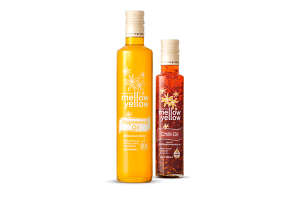 Oils
Oils Rapeseed Oil
Rapeseed Oil Chili Oil
Chili Oil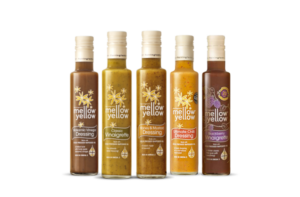 Dressings
Dressings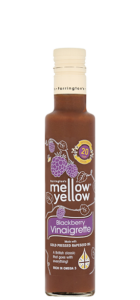 Blackberry Vinaigrette
Blackberry Vinaigrette Classic Vinaigrette
Classic Vinaigrette Balsamic Dressing
Balsamic Dressing Honey & Mustard
Honey & Mustard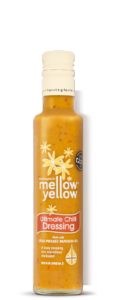 Ultimate Chilli Dressing
Ultimate Chilli Dressing